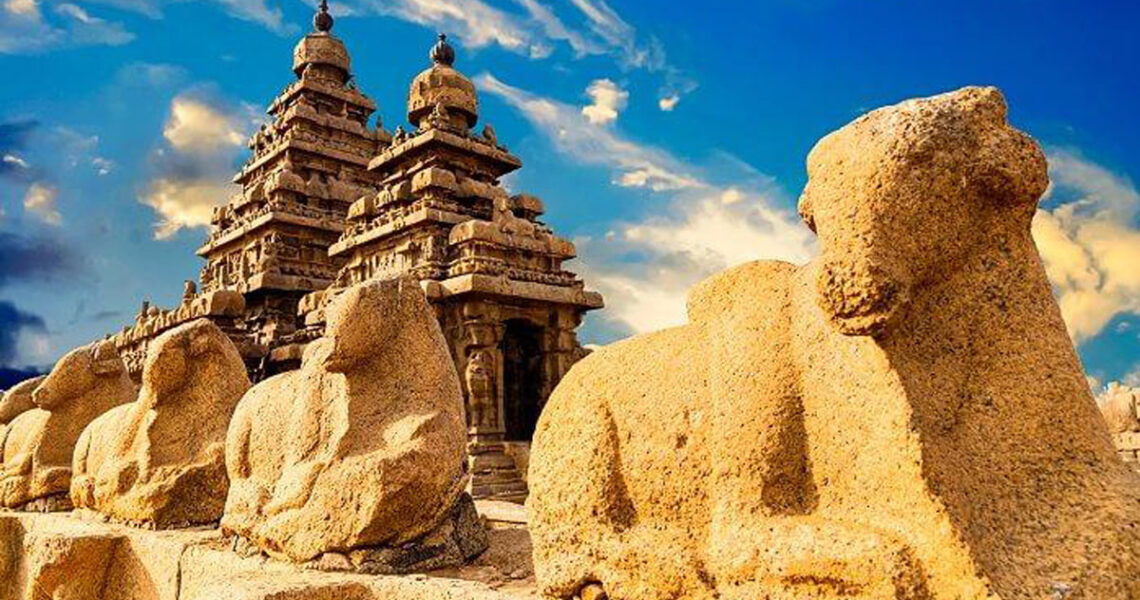Legend of Mahabalipuram
The ancient city of Mahabalipuram has been called the town of the seven pagodas ever since the first reached the city several centuries ago. According to legends, previously Six temples along with the present Shore temple stood here. In terms of myth, Lord Indra grew jealous of this earthly city and sunk the six temples under water during a great storm. Only the Shore temple remained above the sea level. The local fishermen claim to have had glimpses of the other temples below water. However, the legendary city still has historical monuments to stun you. So let’s explore them.
The shore temple complex: Several studies have been constantly conducted on this site by the Archaeological Society of India in collaboration with international agencies and Navy. The excavations have thrown up evidence that a large network of temples once existed along the coast of Mahabalipuram. The Shore temple is the only standing temple on board. The remains of a temple approximately one-and-a-half times the size of the still standing Shore Temple structure, plus a smaller temple on the same excavation site, have been laid bare by the excavations. After the tsunami of 2004, about 500 m was pulled back by the sea. During this time a large row of rocks emerged from the water. The tsunami also made some permanent changes in the coastline uncovering previous covered statues and small structures. One of the remarkable is a large sitting lion statue on the Mahabalipuram beach. Such recent occurring and excavations have suggested that the myths about the seven pagodas might be true. This is an everlasting tale.
The Ganesh Mandapa: Apart from the seven pagodas, other monuments of the epic city also draw attention. The main hill of Mahabalipuram is dotted with pillared halls carved into the rock face. They have graceful carvings and intricate columns with figure structures. The Ganesh Mandapa is an active shrine till today featuring an elephant god of the fourteen century. The figurine is seen with reverence and faith.
Varaha Mandapa: This is dedicated to the two avatars of Lord Vishnu. It stands behind the circular rock called Krishna butter ball. The Mahishasuramardini mandapa has the goddess Durga in bas relief and the Vishnu Sayana Mandapa shows Lord Vishnu lying under the protective hood of the seven-headed serpent Adishesha. There are other caves having unfinished Krishna Madapam, Rayar Gopuram and the Trimurti temple.
Olikaneeswara Temple light House: According to records, the first conventional light house was established in 1887 by placing a wick lamp inside a 4th order optic and lantern of the Olikaneeswara temple roof. It stands at the top of Mahishasuramardini cave. Recently another lighthouse has been built.
The eight Rathas: The smaller hill of Mahabalipuram contains the eight rathas which are monolithic temples fashioned as chariots. Five of these chariots have been named after the Pandava brothers and one after Draupadi. This is because the Pandava brothers were heroes of the Hindu epic Mahabharata. The largest among these is the Dharamraja Ratha while the others such as Arjuna and the Bhima chariots are the lesser copies of the Dharamraja Rath.
Arjun’s Penance: One of the largest bas reliefs in the Mahabalipuram is the Arjun’s Penance. It is one of the largest in the world as well. It portrays the penance of Arjun for Lord Shiva to obtain the celestial weapon for destroying his armies.
Other structures: According to common beliefs, another popular structure depicts King Bhagirath’s penance to Lord Shiva to bring down river Ganges from heaven to purify his ancestors. Lord Shiva pleased by his penance came down to earth and allows Ganges to trickle from his hair into numerous streams all over the world. This was mainly due to the safe flow of water without harming the earth. This strange sight aroused the curiosity of the world’s animals, who gathered round the soaking God. The most remarkable part of this ancient carving is perhaps the cleft in the two rocks. It represents Lord Shiva ascending from heaven through the celestial waterfall. A stone water tank ruins above a rock give evidence for this interpretation.
Modern day Mahabalipuram: Various excavations are continuously going on to innovate the ancient city. You must certainly visit this city, is sure to travel you back to the times. It’s glorious past and reminiscent carvings are timeless. We can surely hope that in the near future all the seven pagodas will stand high on the beach to restore it’s pristine glory. Mahabalipuram was an important port built by the Pallavas during the Seventh Century for the maritime trade with the countries of South East Asia and Mediterranean. The temples of Mahabalipuram proudly showcase Rock-cut architectures.
So hopefully next time you visit this legendary city the seven pagodas will welcome you. Keep following us for more. We will be back soon. Stay safe and healthy.
